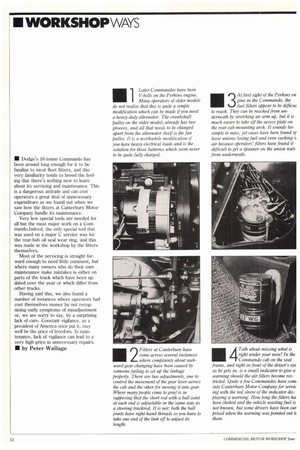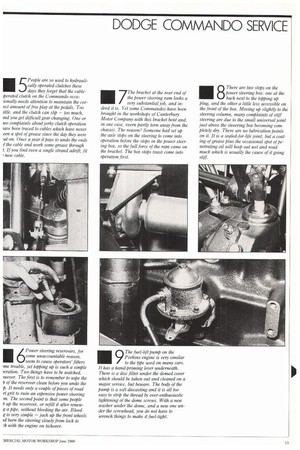1 Later Commandos have twin V-belts on the Perkins engine.
Page 72

Page 73

Page 74

If you've noticed an error in this article please click here to report it so we can fix it.
Many operators of older models do not realise that this is quite a simple modification which can be made if you need a heavy-duty alternator. The crankshaft pulley on the older models already has two grooves, and all that needs to be changed apart from the alternator itself is the fan Pulley. It is a worthwhile modification if you have heavy electrical loads and is the solution for those batteries which seem never to be quite fully charged.
2 Fitters at Canterbury have come across several instances where complaints about awkward gear changing have been caused by someone failing to set up the linkage properly. There are two adjustments, one to control the movement of the gear lever across the cab and the other for moving it into gear. Where many people come to grief is in supposing that the short rod with a ball joint at each end is adjustable in the same way as a steering trackrod. It is not: both the ball joints have right-hand threads so you have to take one end of the link off to adjust its length. 3 At first sight of the Perkins en gine in the Commando, the fuel filters appear to be difficu4 to reach. They can be reached from underneath by stretching an arm up, but it is much easier to take off the access plate on the rear cab-mounting arch. It sounds too simple to miss, yet cases have been found of loose unions losing fuel and even sucking ji air because operators' fitters have found it difficult to get a spanner on the union nuts from underneath.
4 Talk about missing what is right under your nose! In the Commando cab on the seat frame, and right in front of the driver's eye as he gets in, is a small indicator to give a warning should the air filters become restricted. Quite a few Commandos have corm into Canterbury Motor Company for servic ing with the red sleeve of the indicator displaying a warning. How long the filters ha been choked and the vehicle wasting fuel is not known, but some drivers have been Sue prised when the warning was pointed out t( them. U Pate iotpyle aerreatseoducsluedkhtoeshytdr saeuli days they forget that the cableoerated clutch on the Commando occaionally needs attention to maintain the cored amount of free play at the pedals. Too ittle, and the clutch can slip — too much, rnd you get difficult gear changing. One or wo complaints about jerky clutch operation lave been traced to cables which have never een a spot of grease since the day they were lit on. Once a year it pays to undo the ends [ the cable and work some grease through t. If you find even a single strand adnft, fit ! new cable.
IsP.00werustee cnohugntreselervoirs reason,, for seem to cause operators' fitters ome trouble, yet topping up is such a simple ieration. Two things have to be watched, nvever. The first is to remember to wipe the p of the reservoir clean before you undo the 75. It needs only a couple of pieces of road rt grit to ruin an expensive power steering 'tn. The second point is that some people 5 up the reservoir, or refill it after renewg a pipe, without bleeding the air. B leedg is very simple — jack up the front wheels Id turn the steering slowly from lock to sh with the engine on tickover. 7The bracket at the rear end of the power steering ram looks a very substantial job, and indeed it is. Yet some Commandos have been brought in the workshops of Canterbury Motor Company with this bracket bent and, in one case, evern Partly torn away from the chassis. The reason? Someone had set up the axle stops on the steering to come into operation before the stops in the power steering box, so the full force of the ram came on the bracket. The box stops must come into operation first. 8 There are two stops on the power steering box: one at the hack next to the topping up plug, and the other a little less accessible on the front of the box. Moving up slightly to the steering column, many complaints of stiff steering are due to the small universal joint just above the steeering box becoming completely dry. There are no lubrication points on it. It is a sealed-for-life joint, but a coating of grease plus the occasional spot ofpenetrating oil will keep out wet and road muck which is usually the cause of it going shff.
9 The fuel-lift pump on the Perkins engine is very similar to the type used on many cars. It has a hand-priming lever underneath. There is a disc filter under the domed cover which should be taken out and cleaned on a major service, but beware. The body of the Pump is a soft diecasting and it is all too easy to strip the thread by over-enthusiastic tightening of the dome screws. With a new washer under the dome, and a new one under the screwhead, you do not have to wrench things to make it fuel-tight. 1 complaints atotsulad never utleabekaagney from the rear hubson a Commando because of a worn stub axle. The surface on which the grease seal runs is a thin renewable ring. It has to be a tight fit on the hub, and some operators' fitters complain that they cannot fit a new one without damaging it. Some even try heating it up to expand it to make it go on more easily, but this usually distorts it. The answer is a simple "special tool" which can he, mode in any workshop.
1 This is the simple tool that makes putting on the grease seal wear ring so simple. This one was made in the workshops of Canterbury Motor Company from a piece of steel tube large enough to fit over the hub, with a flat disc spot welded over the end to press on the wear ring. Put the ring in position, put the sleeve on, do up tiw hub nut and the ring slides easily into place. 12 Even with all the seals and gaskets in good condition you might still get leakage if you neglect this little item which sits on the axle casing to one side of the differential housing. It is the breather which allows air inside the casing to escape when it heats up during running. It is in a very vulnerable position and frequently gets choked with road dirt or, in severe winters, with frozen mud. If it is not kept clear the build-up of pressure inside the casing can blow oil out of the axle. 1 The rocker clearances on
the "dot 4" Perkins engin are different from those a the earlier versions. The clearances are given on a small plate on the top of the rocker cover underneath the cab mounting arch. If you get them wrong and set the clearances to the old figures, you will undoubtedly burn out exhaust valves and possibly damage the seatings as well — an expensive business which is quite unnecessary.
1 Ill i.hs is valve corm There are two adjustments to make on th linkage: one on the operating length of th rod and the other a choice of holes on the axle mounting bracket on to which the ro fits. The workshop manual will give guidance on setting, but Canterbury Mot says that the only way to make sure that . valve is operating at its correct setting is use a rolling-road break tester and a loch simulator, neither of which are found in average operator's workshop.
















































































